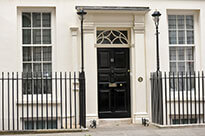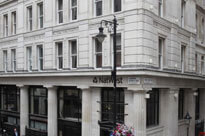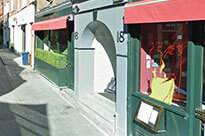5th April 2016
12mins
Shifting scenes for London buyers

Figures from estate agent Hamptons International show Russian buyers accounted for just 1% of purchases in prime central London (PCL) in 2015, down from 6% in 2014. Similarly, Chinese buyers now make up 2% of the total, down from 8%.
However, other overseas buyers are taking their place. The recent strong performance of India’s economy has boosted the fortunes of top industrialists and entrepreneurs from the Subcontinent, encouraging some of them to look for properties in London. As the Hindustan Times recently commented, some 3,000 Indian families own prime central London property, attracted by the UK’s stability as an investment destination.
“We’ve seen an uptick in instructions from Indian clients, who are particularly keen on new-build and off plan purchases,” says Camilla Dell, Black Brick Managing Partner. Such properties often involve staged payments, which suit resident Indians, who are restricted to remitting no more than $250,000 per family member each year. Meanwhile, those with international business interests face fewer constraints, and are showing interest in higher value properties.
“As we’ve noted before, it’s important for buyers of new build properties to get good advice,” says Dell, who points out that, in Mayfair alone, there are more than half a dozen new build developments on the market. “New build contracts can also be tricky, and can contain unfavourable clauses preventing a buyer from assigning the contract before completion, for example. We are experts in what to look out for and have an enviable track record of renegotiating new build contracts to favour buyers.”
“And while it may be a buyer’s market for £5m-plus properties, buyers should take advice to ensure they don’t overpay. Since the start of the year, we’ve been able to negotiate an average of 15% off asking prices,” Dell adds.
Meanwhile, the Hamptons research suggests that Russian and Chinese buyers remain active in the market – but are looking for cheaper properties outside prime areas. Russians bought 11% of properties in inner London areas including Clapham, Islington and Pimlico last year, up from 2% the year before, while Chinese buyers rose from zero to 2% of demand in outer London boroughs.
Indeed, leading agent Knight Frank has identified a significant performance gap between traditional PCL areas in the west of London and emerging prime regions including City & Fringe, Islington, Southbank, King’s Cross and Riverside. In response, it is now treating these parts of London as a separate prime market, which it is calling PCL East, with its own set of price forecasts. While PCL East is in line for 26.4% growth between now and 2020, PCL West (Noting Hill, Kensington, South Kensington, Chelsea, Knightsbridge, Belgravia, Hyde Park, Marylebone, Mayfair and St Johns Wood) is expected to manage just 10.2%.
At Black Brick we have a team with over 100 years combined experience across all of London and the Home Counties. In addition to operating in PCL, we have helped buyers in the last 12 months in many areas that other buying agents do not cover, such as Walthamstow, Shoreditch, Islington, Maida Vale, White City and Golders Green. We are therefore well placed to help clients that are looking for value beyond PCL West and, for that matter, PCL East as well.
2016 Budget: Residential relief, commercial curses

Of most note was the clarification of the stamp duty surcharge, previously announced on buyers of second properties and buy-to-let investment. Some commentators were initially dismayed that landlords with more than 15 properties would be subject to the 3 percentage point stamp duty surcharge, which comes into effect on 1 April. It had been hoped that larger property investors would be exempt, to encourage institutional investment in the build-to-rent market.
However, the Treasury has since clarified the situation, pointing out in an email sent to those who responded to its consultation on the issue that there are already “significant flexibilities” in the stamp duty system available to “significant investors in the property market”.
These include multiple dwellings relief and the ability to pay the non-residential rates when purchasing six or more properties in the same transaction. ”Both of these flexibilities will remain,” the email said.
Commercial property buyers were, however, singled out. Properties worth less than £150,000 will now face no stamp duty, those between £150,000 and £250,000 will be subject to 2% duty, and those above £250,000 to 5%. This compares with the current flat rate of 4%.
The Chancellor said that only 9% of buyers would pay more, but the British Property Federation railed against the change, which it described as an “out of the blue raid” on the sector. Indeed, the Treasury expects the changes to raise an additional £385 million in 2016-17, rising to £590 million by 2020-21.
“After the surprises we’ve seen from the Chancellor in recent budgets, it’s a huge relief he didn’t spring anything else on the residential sector this time round,” says Camilla Dell, Managing Partner at Black Brick. “As it is, we expect to see the flurry of deals we’ve seen ahead of the April deadline come to a screeching halt. We’re hopeful that institutional investors will pick up some of the slack in the buy-to-let market, otherwise we’re going to see rents rise and London become even less affordable to renters.”

Dell at Black Brick says that the move is a sensible one, and may help to reduce the risk of a speculative bubble forming in the buy-to-let market, which will increasingly be dominated by more liquid, wealthier cash buyers. The various changes to tax rates, and these latest restrictions, mean that buy-to-let investing remains viable if borrowing 50% or less of the value of the property, she adds.
But it’s not just smaller investors who are finding financing harder to come by. New figures suggest that property developers have seen bank funding slashed in the last two years, forcing them to put development projects on ice. According to Funding Options, an online business finance supermarket, banking funding fell to £16bn in January this year from £34bn in the same month in 2014. While banks are happy to offer longer-term secured loans and mortgage finance, they are proving less willing to offer shorter term funding, the report finds.
At Black Brick, we offer a property development service designed to help both specialist and non-specialist investors undertaken residential property development. As part of the service, we help to put the funding in place to underwrite development opportunities, with access to providers of both equity and debt.
“Bank debt may be harder to obtain than in the past but, in this low interest-rate environment, there are investors ready to offer funding,” says Black Brick’s Hotel and Development Consultant Edward Minter. “It’s a question of matching the right opportunity to the right investor. We also have excellent relationships with the right brokers and private banks and we regularly help source finance for hotel and development deals for our clients”.
Acquisition of the month 1 – Eaton House, Mayfair W1

We also introduced our client to a suitable lender who could provide financing that was able to accommodate the remittance restrictions. However, during the conveyancing process, it emerged that the property was held under two leases, one of which contained highly restrictive provisions on reselling. Rather than de-railing the purchase, we were able to negotiate with the immediate owner to vary the lease, and to pay the £65,000 premium involved. In addition, we were able to negotiate £400,000 off the asking price, to secure the property for a highly competitive £2.8 million.
Acquisition of the month 2 – Bank Chambers, St James’s SW1


According to The Times, it’s the only restaurant in London, excluding hotels and private clubs, which she has eaten in since her coronation in 1953. While we at Black Brick usually grab a sandwich at our desks, we can wholeheartedly recommend Bellamy’s. It’s a great place for a smart business lunch and they serve up some of the best fish dishes in London.
In addition to the services we offer property buyers, we periodically act for clients selling properties. This month, we have three new prime London properties on our books:



For more details, to arrange a viewing or to see what else we are currently selling please contact Caspar Harvard Walls chw@black-brick.com or call +447827277741.
We would be delighted to hear from you to discuss your own property requirements. For a non-obligatory consultation, please contact us.